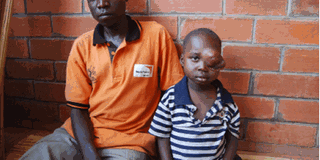Four-year-old cancer fight hangs in balance

Nancy Auma seated with her father Isaac Odong at St Mary’s Hospital Lacor,Gulu District. PHOTO BY JOSLINE ADIRU
What you need to know:
- Four-year-old Nancy Auma has never stepped into a classroom setting as she is always in and out of hospital. What her parents thought was an insect bite turned out to be a cancerous swelling that has altered the course of her life.
- Signs and symptoms
Rhabdomyosarcoma usually manifests as an expanding mass. Tumors in superficial locations may be palpable and detected relatively early, but those in deep locations (eg, retroperitoneum) may grow large before causing symptoms. - Symptoms depend on the location of the tumor, and pain may be present. Typical presentations of nonmetastatic disease, by location,
Desperation and cries of helplessness welcome you as you enter the children’s cancer ward at St Mary’s Hospital Lacor, Gulu District. When I enter the ward, my attention is drawn to four-year-old Nancy Auma. According to her attendant, Auma is suffering from Rhabdomyosarcoma. This is a malignant tumour (“cancer”) that arises from a normal skeletal muscle cell. The cancer has affected the soft tissues and caused swelling on her left eye.
When Auma was one year old, she got an insect bite like swelling in her left eye, since she was too young, she could not explain to the parents how she was feeling. A few weeks later her father Isaac Odong took her to Kitgum hospital since the swelling persisted.
“We were not worried by then because we thought it was just an eye infection that would be easily healed after treatment from the main hospital,” Odong says.
In 2013, when the condition worsened, they were referred to Gulu Regional Referral Hospital to see an eye specialist which they did. The little girl underwent surgery at Mulago hospital where they were referred to for further treatment.
Although there was an operation on the eye, there was no relief from the pain, it persisted, Odong says, adding that as parents they even lost hope.
In April, another big swelling started protruding from her eye with pus-like discharge and when they went to Lacor hospital, where they were told that the little girl had cancer and it was in its advanced stages.
Francis Okongo, the palliative care specialist at St Mary’s Hospital Lacor, says, “This type of cancer when detected early, can be treated.”
He says sometimes health workers who have no specialty in cancer diagnosis and treatment can give wrong diagnosis on certain conditions yet it could be sign or symptom of cancer.
Okongo notes that most victims end up not seeking adequate medical treatment for cancer because it is an expensive disease. He says many locals cannot afford transport to medical facilities let alone treatment for cancer.
When we asked the hospital authorities what fate holds for Auma, MaryAnn Gleason, a clinical officer at St Mary’s Hospital Lacor, says when cancer is in advanced stages, it is difficult to manage it at the facility and such patients are referred to Mulago Hospital for better treatment.
“We can only do surgery on the affected area but there are other steps required for complete treatment such as radiotherapy and chemotherapy yet the facility does not have the machines for these services, we end up losing many patients,” says Gleason.
Those are realities that Odong and his family have to face as they try to improve the livelihood of their daughter hoping she will beat the disease.
Odong says everyday he has to live with the fact that his daughter is not like the other children and may never sit in a classroon like children her age.
“Just like any other parent I am helpless when I see my child in pain and that she cannot even play just like other children of her age,” he shares.
Asked how he manages to cope, Odong says in the past they used to get support from a non-governmental organisation but now they have to rely on handouts. At times there are no drugs at the facility and this affects the routine dose of cancer treatment being given to patients.
But in spite of these setbacks he remains hopeful. “There is some relief in the pain compared to what she has been going through in the past. Now she can play around with the fellow children at the hospital,” he says.
Treatment
According to information from the National Cancer Institute website, the treatment of childhood rhabdomyosarcoma often includes surgery, radiation therapy, and chemotherapy.
The order that these treatments are given depends on where in the body the tumor started, the size of the tumor, the type of tumor, and whether the tumor has spread to lymph nodes or other parts of the body.
For now, Odong can only hope that his little girl will get better considering that the first line of treatment did not work.
Signs and symptoms
Rhabdomyosarcoma usually manifests as an expanding mass. Tumors in superficial locations may be palpable and detected relatively early, but those in deep locations (eg, retroperitoneum) may grow large before causing symptoms.
Symptoms depend on the location of the tumor, and pain may be present. Typical presentations of nonmetastatic disease, by location, are as follows:
Orbit: Proptosis or dysconjugate gaze
Paratesticular: Painless scrotal mass
Prostate: Bladder or bowel difficulties
Uterus, cervix, bladder: Menorrhagia or metrorrhagia
Vagina: Protruding polypoid mass (botryoid, meaning a grapelike cluster)
Extremity: Painless mass
Parameningeal (ear, mastoid, nasal cavity, paranasal sinuses, Upper respiratory symptoms or pain.)




